
Saudi Arabia
He extended his arm and said, “Marhaba, tegah”, Arabic for “Welcome, have some”. In his palm was a cup of Saudi Arabian coffee. Coffee is served from the “Dallah”, a traditional coffee pot, and is the symbol of hospitality in Saudi Arabia. While visiting the Kingdom, we were greeted from morning til evening with this kind gesture.


We received a special invitation to spend 10 days in the Kingdom of Saudi Arabia. Our travels took us from Riyadh, the capitol city, to historic sites in Al-Ula in the far northwest, and the Empty Quarter in the south, the largest sand desert in the world.




Sharing some highlights from our fascinating trip into this unique Kingdom where there are 2,000 archaeological sites, 2 Holy Cities – Mecca and Medina, and over 30 million people. Here’s an abbreviated overview of where we went and what we did.


Riyadh, the Capitol City
Before leaving my hotel room, I put the traditional black abaya robe over my head, and it fell to the ground covering my clothes. Then I placed a headscarf over my head. When traveling, I believe it’s important to show respect and wear the traditional dress. Admittedly, it took a few days to get used to it and luckily, it was the winter season so it didn’t get too hot.
We met our group in the lobby at the Radisson Blu Hotel, and set out to discover Riyadh – the Souk, Fort Masmak, Murraba Palace, the National Museum, Justice Square and the old town of D’Iriyah.


-
Kingdom Tower:
The iconic Kingdom Tower stands out in Riyadh’s skyline, recognized by its giant necklace shape. From the Top Floor, you can get 360 degree views, and get oriented to the layout of the city. For ladies, don’t miss! Stop at the Ladies Kingdom where ONLY women are allowed to shop on the second floor of the mall. You’ll see spectacular boutiques with designer gowns, salons where women go to get pampered, and have access to a special experience.


-
Fort Masmak:
Dating back to 1865, this citadel played a pivotal role in the development of the Kingdom of Saudi Arabia. In 1902, King Abdulaziz, known as Ibn Saud, and his followers seized Fort Masmak, and united the tribes of Saudi Arabia. By 1932, the Kingdom of Saudi Arabia was formed, and has developed dramatically in the past 85 years.


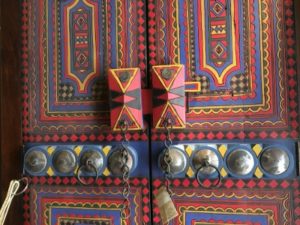
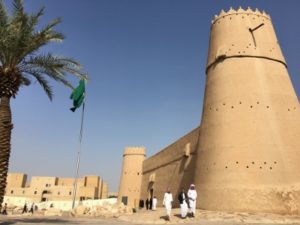
-
Souq Al Thumairi:
One of the most popular souks in Riyadh! We entered the market maze, and found ourselves in the middle of an auction where locals were selling their antiques. Stopped at a few more stalls where you can find authentic handicrafts, carpets, prayer beads, Saudi dates, coffee pots, gold jewelry, swords, silver daggers, and Bisht cloaks, a traditional Arabian long coat that men wear over their robes (in Arabic, the thobes). Our shopping came to an abrupt halt, when there was a Call to Prayer. Shop keepers quickly close their doors and faithfully make their supplications to Allah (God), before returning to the store and opening it again. Brid Beeler, our local expert, is an expat who lived 10 years in the Kingdom, and she knew exactly where to take us. I followed her to the spice store, and picked up whatever she was putting in her basket. We stocked up on frankincense, myrhh, giant cinnamon sticks, saffron, pine nuts, white figs, and Saudi dates.



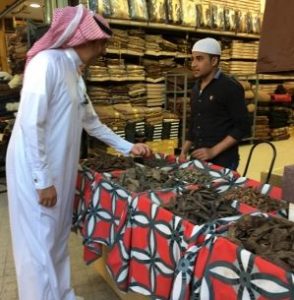

-
Deera Square & the Grand Mosque:
Our guide took us through Deera Square (also known as Justice Square), and the beautiful Grand Mosque – Turki Bin Abdullah. We weren’t allowed to enter the Mosque, but we peeked through the entrance.
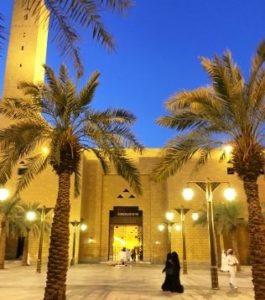

-
National Museum:
We visited the National Museum where there were interactive displays, and lots to learn about the ancient Kingdoms of Saudi Arabia, as well as a vast collection of artifacts.

-
Old City of D’Iriyah:
This is the first capital of the Al Saud’s, the ruling Saudi family – dating back to the 16th century. Located near Wadi Hanifa in Riyadh, close to the Diplomatic Quarter. We explored the labyrinth of adobe style architecture. There are many colorful doors with ancient tribal designs. Looking out from an overlook in the new town, we saw the restoration of the Old City, where many of the town’s outer walls have been restored, and major renovations are taking place in the old capital. As we meandered through the alleyways, shop keepers welcomed us into their stores, and the Saudi people were friendly, and curious to meet us. Our group was impressed to see many families sitting on the grassy lawns, enjoying picnics and time together. I saw a young father taking a “family selfie” and joined in the photo. After the sun set, we went to a traditional Arabian dinner at Najd Village in the old Diriyah city, where traditional Saudi style cuisine was presented on a floor mat, and everyone dined while sitting on the carpet. A variety of dishes from camel, beef, chicken, and veggie platters. It was a colorful spread & so delicious! Don’t miss: seek out the bread oven, and watch how they make the large pita rounds.



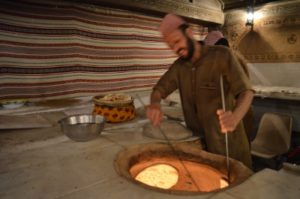
Al-Ula, Adventures in Northwestern Saudi Arabia
We flew from Riyadh to Al Ula in the northwest of Saudi Arabia, located about 270 miles south of Jordan’s Aqaba. When landing, it was as if we arrived to Sedona, Arizona. The landscape is similar with canyons and unique rock formations.


Our two-day visit included seeing the Lihyanite tombs, and the famous Mada’in Saleh UNESCO archaeological site. We stayed at Madakhil, a traditional Saudi style tented camp, with comfortable beds, topped with plush comforters. After dinner, we retired to the black goat haired Bedouin tent adorned with exotic carpets, big cushions and pillows. Some read, others sat around an open fire and sipped cups of tea, while listening to our guides share old tales of Arabia and recite poetry. Looking into the open midnight sky, we gazed at millions of stars in the sky. Magical!
-
Lihyanite Tombs:
On our way to the Lihyanite Tombs, we stopped to visit the Old Town of Al-Ula situated near a date palm oasis. We walked through the interior hallways of ancient Al-Ula, saw the old ruins of the fort, and visited the place where a bustling market catered to traders following ancient caravan routes.




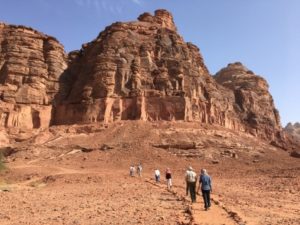
-
Mada’in Saleh – UNESCO Archaelogical Site:
Next to Petra, Jordan, Mada’in Saleh was the second most important city during the times of the Nabateans. Famous for its colossal carved tombs that date back to 200 BC, we walked through the Al-Hijr Site that is spread over about 10 miles, where several rock-cut tombs, prayer halls, water cisterns, and settlement areas are located. Here are the main sites: Qasr Al Bint, two blocks with over 29 tombs, Qasr Al-Saniya, the Al Khuraymat with over 53 tombs decorated with intricate motifs, the Addiwan, and finally, the grandest rock-cut tomb, the Qasr Al Fareed “Unique Palace”, carved from a single rock monolith. Finally, we visited the sacred Ethlib Mountain and Dewan area where the Nabateans performed rituals and religious ceremonies. There are 131 tombs with ornate facades from the ancient Nabatean Kingdom in Mada’in Saleh, called the Al-Hijr Archaeological Site by UNESCO.





-
Rock Formations:
The landscape of this desert canyon region is other worldly with gigantic towers of rock. There was even a rock in the shape of an elephant! We hopped in our 4X4 vehicles and went on a desert safari through this rugged terrain covered in sand. On some of the rocks, we discovered petroglyphs and drawings of camels, lions, and other animals, as well as inscriptions from ancient civilizations. When spring arrives, the desert area is covered in bluebells, poppies, daisies and roses of desert quartz.



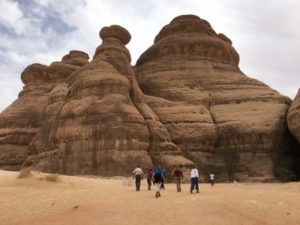


-
Hijaz Railway Line:
In the 1930’s, efforts were made to build a railway that followed the old caravan routes. This railway line was made famous by T.E. Lawrence during WWI, and we visited the museum, railway cars, and steam engine that are no longer in use. There is also the Al-Hijr Fort nearby that’s worth a visit. On our journey to Tabuk, we followed the train tracks towards Tabuk, just like the Nabatean’s traveled by camel, and the pilgrims came to Makkah on the Haj and Umra.
Empty Quarter, Largest Sand Desert in the World
Our last few days were spent in the Empty Quarter, the largest sand desert in the world. Situated in the Southern part of the country, we flew to Wadi Al Dawasir from Riyadh, where our Bedouin guide and Saudi team of drivers picked us up in 4X4’s and drove us to our first night’s camp in the Ar Rub Al Khali.


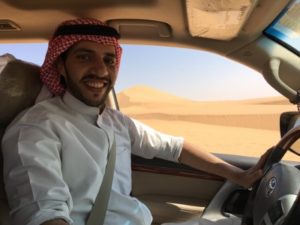
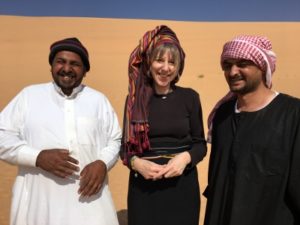
When we arrived to camp, we had a light supper of dates, fruits and tea under a sparkling desert sky, then retired to our Western style tents in the middle of the desert.
At dawn, we awoke to see endless sand dunes with patterns that shift and change with the winds. After our breakfast of scrambled eggs, pita, cucumbers and tomatoes, we continued our 6-car caravan deep into the desert.
Over the next few days, we drove 300 miles across the desert and stopped to visit the ruins at the ancient site of Quaraiyat Al Fau, capital of the Kinda Kingdom (1st century BC) on an ancient trade route, and continued to 5,000 yr. old lakebeds covered with fossils, stone tools and Neolithic arrowheads.
Our adventure through the desert was luxurious, compared to crossings by British explorers Wilfred Thesiger and Bertram Thomas who traveled by camel with Bedouin tribes. We caravanned in comfort through the desert and listened to the tunes of the famous Saudi singer, Abo Baker Salem.
Reminder! A great read before, during or after a visit to the Empty Quarter – Arabian Sands by Wilfred Thesiger.
Good to note: Be sure to bring a ghutra (or headscarf) to protect you from the sun and wind. There are a dozen ways to tie these headscarves, and I tried to learn how our Bedouin guides and Brid, the elegant expat did this. Brid made it look easy and her headscarf always turned out looking like she was the Queen of Sheba. My failed attempts resembled something like a dishtowel on my head or a head wound bandage.

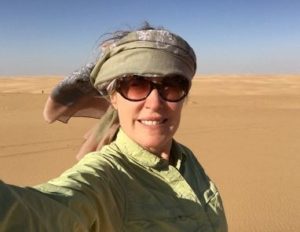
From flat desert floor to the high dunes, we were grateful to have Ali, the expert Bedouin tracker, to lead us through a sand desert, the size of France! In the early morning and at dusk, we trekked the sand dunes, called Urgs, and learned each dune has a name. As minutes passed, we watched the shadows and light on the sand change. Without Ali, it would be easy to get disoriented, then lost, as many locals and expats have met their fate in the dunes.


Although we didn’t see any gazelle or oryx, we saw the birth of a baby camel, and came across a herd of camels with lots of babies – almost 100! The sun was setting, and the camels followed each other in a line and passed by us. The Bedouin family who owns this herd, said it was serendipitous that we arrived when the baby was born, and invited us for an authentic Bedouin dinner. They were going to kill one of their hundred camels, and prepare it for our dinner! We had to get to camp, and politely declined their generous invitation. In this region of the world, camels are considered real treasures and highly valuable. For centuries, they’ve been used for transport, milk, wool, and meat. Today, there are camel beauty contests, and camel racing competitions where a camel can be valued up to 2 million!? Perhaps this is in riyals, but even so, high priced camels.


On our last day, we drove back to Riyadh and past the Layla Lakes area, and continued back through flat desert terrain.
Our adventures in the Kingdom of Saudi Arabia were coming to an end, and soon we’d be flying out of Riyadh. I feel fortunate to have been invited to visit this Kingdom, where we met so many gracious and hospitable people, and learned about the rich history of a country that has grown into a wealthy nation. Many would think its greatest resource to be oil, but I found the Saudi people to be its greatest treasure.
Insights & Observations
We gathered many insights during our visit to the Kingdom, based on our observations from guides and the people we met. Here are a few:
- Saudi Arabia is a young country. The Kingdom was founded in 1932, and has developed rapidly.
- Women are highly respected, and mothers are elevated to the highest position of respect, obedience and kindness in the Islamic faith, and in the Kingdom.
- Families are united and share strong bonds. We observed many families demonstrating their love with hugs, and kisses.
- Women have a choice who they marry. Almost 90% of marriages are arranged, but both the bride and groom to be have a choice if they want to marry. Men feel it’s their duty to provide for the wife and family. They are required to present a valuable dowry to the wife and her family.
- Women do not walk behind the men, and have the right to vote and hold public office.
- Many women choose to work, and are successful entrepreneurs. In fact, 70% of women attend the university.
- And surprisingly, women like to wear the abaya robe, and many consider it “slimming”, fashionable. Young girls can hardly wait to grow up and wear one. Like young western girls who want to hurry and grow up to wear lipstick and wear high heels.
- Tourism is primarily for Islamic pilgrims visiting the most holy cities and sites for Muslims – Hajj at Mecca, or Expats who live/work in the Kingdom, and visitors with business visas.
INTERESTED IN THIS TRIP?
Interested in visiting The Kingdom of Saudi Arabia?
Email us for more information: Info@GlobalAdventuress.com
We can introduce you to one of the leading tour companies for travel to the Kingdom of Saudi Arabia.

Acknowledgements
Acknowledgements
Global Adventuress would like to thank North Face and Nuun for providing supplies during this journey. Also, a special thanks to Mountain Travel Sobek and to the several guides who introduced us to this fascinating country.


Highlights, insights and notes referenced in this article are sourced from our itinerary, guide’s remarks and observations made during our 10-day trip.
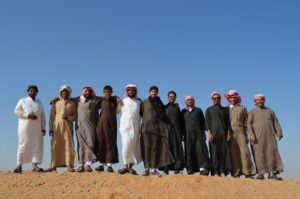
This trip was paid for by GlobalAdventuress.com
In recommending and offering trips, Global Adventuress, LLC, acts only as an independent marketing agent for separate and independent tour companies. Click here for details.




Such a beautiful read! Thank you for shareing
thank you Nader! It’s a beautiful country and there’s so much to explore.
firstly it was great writing. l just wonder how you got the visa to visit the Kingdom.As far as l know there’s no tourist visa . l wanna travel to the Kingdom as well. How can l do this. Thank you.
thanks for your inquiry – we received a special invitation to visit. Hoping in the future, there will be tourist visas so the Kingdom of Saudi Arabia will be a place for more people to discover.
I felt so happy to read your opinion about our culture and my country and how Saudi people are generous and open minded. Its out pleasure to have tourism from different country to enjoy their visit and to trully know about SAudi Arabia and Saudis. Hope u do it again
Thank you Saleh for sharing your comment. We hope we visit again soon!
I’m so happy that you enjoyed your trip to my country the love of my life the air that I breath and can’t live with out Saudi Arabia.
Thank you Jawaher! We love your country and hope to visit again soon.